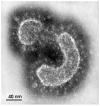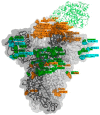Classical and Next-Generation Vaccine Platforms to SARS-CoV-2: Biotechnological Strategies and Genomic Variants
- PMID: 35206580
- PMCID: PMC8877900
- DOI: 10.3390/ijerph19042392
Classical and Next-Generation Vaccine Platforms to SARS-CoV-2: Biotechnological Strategies and Genomic Variants
Abstract
Several coronaviruses (CoVs) have been identified as human pathogens, including the α-CoVs strains HCoV-229E and HCoV-NL63 and the β-CoVs strains HCoV-HKU1 and HCoV-OC43. SARS-CoV, MERS-CoV, and SARS-CoV-2 are also classified as β-coronavirus. New SARS-CoV-2 spike genomic variants are responsible for human-to-human and interspecies transmissibility, consequences of adaptations of strains from animals to humans. The receptor-binding domain (RBD) of SARS-CoV-2 binds to receptor ACE2 in humans and animal species with high affinity, suggesting there have been adaptive genomic variants. New genomic variants including the incorporation, replacement, or deletion of the amino acids at a variety of positions in the S protein have been documented and are associated with the emergence of new strains adapted to different hosts. Interactions between mutated residues and RBD have been demonstrated by structural modelling of variants including D614G, B.1.1.7, B1.351, P.1, P2; other genomic variants allow escape from antibodies generated by vaccines. Epidemiological and molecular tools are being used for real-time tracking of pathogen evolution and particularly new SARS-CoV-2 variants. COVID-19 vaccines obtained from classical and next-generation vaccine production platforms have entered clinicals trials. Biotechnology strategies of the first generation (attenuated and inactivated virus-CoronaVac, CoVaxin; BBIBP-CorV), second generation (replicating-incompetent vector vaccines-ChAdOx-1; Ad5-nCoV; Sputnik V; JNJ-78436735 vaccine-replicating-competent vector, protein subunits, virus-like particles-NVX-CoV2373 vaccine), and third generation (nucleic-acid vaccines-INO-4800 (DNA); mRNA-1273 and BNT 162b (RNA vaccines) have been used. Additionally, dendritic cells (LV-SMENP-DC) and artificial antigen-presenting (aAPC) cells modified with lentiviral vector have also been developed to inhibit viral activity. Recombinant vaccines against COVID-19 are continuously being applied, and new clinical trials have been tested by interchangeability studies of viral vaccines developed by classical and next-generation platforms.
Keywords: SARS-CoV-2; genomic variants; technological platforms.
Conflict of interest statement
The authors declare no conflict of interest.
Figures



Similar articles
-
A mosaic-type trimeric RBD-based COVID-19 vaccine candidate induces potent neutralization against Omicron and other SARS-CoV-2 variants.Elife. 2022 Aug 25;11:e78633. doi: 10.7554/eLife.78633. Elife. 2022. PMID: 36004719 Free PMC article.
-
Covid-19 vaccines and variants of concern: A review.Rev Med Virol. 2022 Jul;32(4):e2313. doi: 10.1002/rmv.2313. Epub 2021 Nov 9. Rev Med Virol. 2022. PMID: 34755408 Free PMC article. Review.
-
Establishment of human post-vaccination SARS-CoV-2 standard reference sera.J Immunol Methods. 2024 Jul;530:113698. doi: 10.1016/j.jim.2024.113698. Epub 2024 May 31. J Immunol Methods. 2024. PMID: 38823574
-
V367F Mutation in SARS-CoV-2 Spike RBD Emerging during the Early Transmission Phase Enhances Viral Infectivity through Increased Human ACE2 Receptor Binding Affinity.J Virol. 2021 Jul 26;95(16):e0061721. doi: 10.1128/JVI.00617-21. Epub 2021 Jul 26. J Virol. 2021. PMID: 34105996 Free PMC article.
-
Properties of Coronavirus and SARS-CoV-2.Malays J Pathol. 2020 Apr;42(1):3-11. Malays J Pathol. 2020. PMID: 32342926 Review.
Cited by
-
Harnessing T-Cells for Enhanced Vaccine Development against Viral Infections.Vaccines (Basel). 2024 Apr 29;12(5):478. doi: 10.3390/vaccines12050478. Vaccines (Basel). 2024. PMID: 38793729 Free PMC article. Review.
-
Towards a Safer Future: Enhancing Vaccine Development to Combat Animal Coronaviruses.Vaccines (Basel). 2024 Mar 19;12(3):330. doi: 10.3390/vaccines12030330. Vaccines (Basel). 2024. PMID: 38543964 Free PMC article. Review.
-
An Overview of Current Accomplishments and Gaps of COVID-19 Vaccine Platforms and Considerations for Next Generation Vaccines.J Pharm Sci. 2023 May;112(5):1345-1350. doi: 10.1016/j.xphs.2023.01.019. Epub 2023 Feb 2. J Pharm Sci. 2023. PMID: 36736775 Free PMC article. Review.
-
COVID-19 Vaccines: An Updated Overview of Different Platforms.Bioengineering (Basel). 2022 Nov 19;9(11):714. doi: 10.3390/bioengineering9110714. Bioengineering (Basel). 2022. PMID: 36421115 Free PMC article. Review.
-
COVID-19 vaccine development: milestones, lessons and prospects.Signal Transduct Target Ther. 2022 May 3;7(1):146. doi: 10.1038/s41392-022-00996-y. Signal Transduct Target Ther. 2022. PMID: 35504917 Free PMC article. Review.
References
-
- Barth O.M., Simões R.S.Q. Virologia Humana e Veterinária. 1st ed. Thieme Revinter Medical; Rio de Janeiro, Brazil: 2019. Vírus emergentes e reemergentes; pp. 317–324.
-
- Simões R.S.Q.S. Animal and Human Coronavirus Disease. COJ Tech. Sci. Res. 2020;2:547.
Publication types
MeSH terms
Substances
Supplementary concepts
LinkOut - more resources
Full Text Sources
Medical
Miscellaneous

